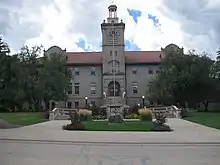James Murdoch (1844–1914)[1] was "an important architect in Denver in the late 19th and early 20th centuries".[2] Several of his works are listed on the National Register of Historic Places (NRHP).[3] At least two of his works have been designated Denver landmarks.[1]
He was born in Scotland in 1844. He arrived in Denver in 1888. He died in 1914.[1]
He served as superintendent of the Colorado State Capitol, with office in the building, and as such was a contributing architect in its completion.[2]

Guggenheim Hall, at Colorado School of Mines
Works include:
- All Saints Episcopal Church (1890), at 2222 W. 32nd Avenue, Denver; NRHP-listed[3][2]
- The Grafton (1890), 1001–1020 E. 17th Avenue, Denver; NRHP-listed[3]
- T. E. Swarz residence (1890), on Pearl Street between 10th and 11th Avenues, Denver; since demolished[2]
- John C. Gallup residence (1891), at 1763 Williams Street, Denver; since demolished[2]
- Worker housing, store, school, offices (1906) in Cokedale, Colorado, a coal mining company town; NRHP-listed as Cokedale Historic District[3]
- Simon Guggenheim Hall, Boulder, at the University of Colorado at Boulder[2]
References
- 1 2 3 "Biography of James Murdoch" (PDF). 1987. "From The History of the 2100 Block Lafayette Street"
- 1 2 3 4 5 6 Carl Jacobsen (October 17, 1977). "National Register of Historic Places Inventory/Nomination: All Saints Episcopal Church / Chapel of Our Merciful Saviour". National Park Service. Retrieved September 18, 2018. With accompanying three photos from 1977
- 1 2 3 4 "National Register Information System". National Register of Historic Places. National Park Service. November 2, 2013.
This article is issued from Wikipedia. The text is licensed under Creative Commons - Attribution - Sharealike. Additional terms may apply for the media files.